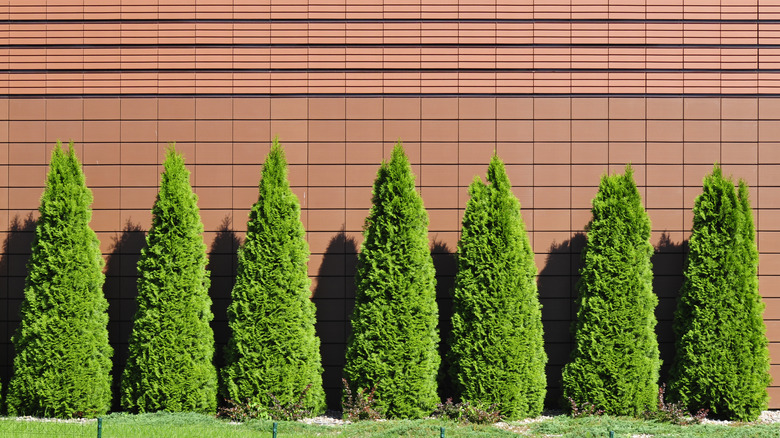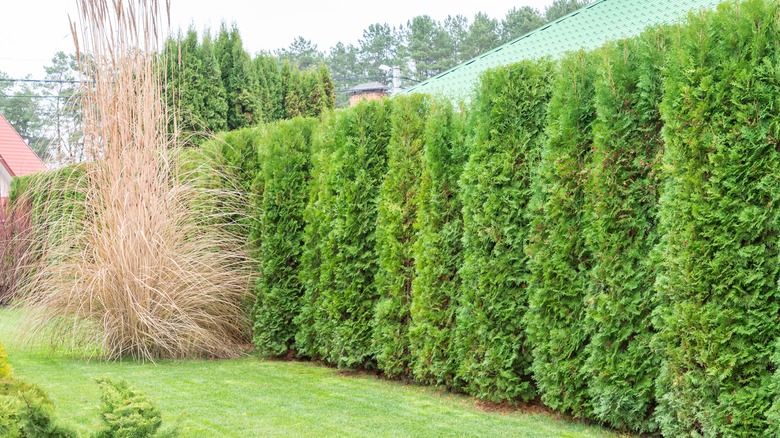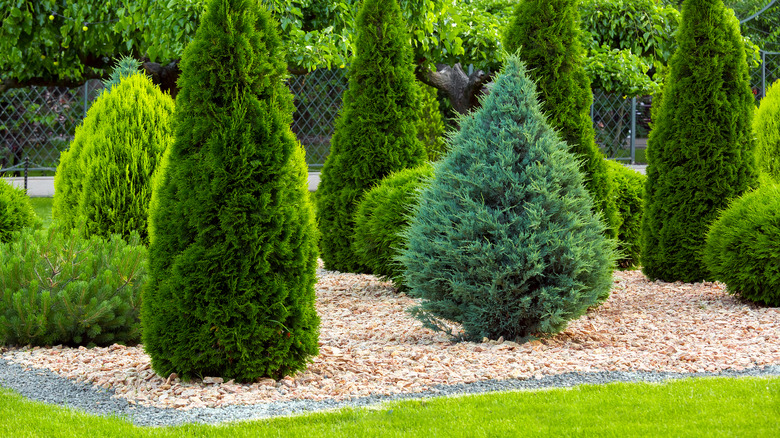The Best Time To Fertilize The Arborvitae Plants In Your Yard
Arborvitae plants are members of the cypress family. The term comes from modern Latin and simply means "tree of life." There are around 15 arborvitae species with the most common belonging to the Thuja genus. There are also around 300 different cultivars. The one that you're probably the most familiar with and might even have growing in your yard is the American arborvitae (Thuja occidentalis), also commonly referred to as the eastern white-cedar or the northern white-cedar. These trees are prized for their lovely pyramidal growth habit and the fact that they are evergreen, which means that they retain their lovely green color all year round — although the foliage can turn yellow-brown in areas with cold winters. This is also a low-maintenance tree that you can grow around your pool for extra privacy. If you have one or more of these trees growing in your yard, the best time to fertilize them is in early spring.
American arborvitae trees can be grown in USDA hardiness zones 3 through 7, and they are excellent as hedging or privacy plants that also provide a place where songbirds can nest. You'll also find that white-tailed deer will use the trees for both food and shelter, especially in the winter. Apart from the American arborvitae, there are other species such as the western red-cedar or giant arborvitae (Thuja plicata) and the deerhorn cedar or false arborvitae (Thujopsis dolabrata).
When to fertilize your arborvitae trees and what to use
The best time to give your arborvitae trees a feed is in early spring as the weather starts to warm up. You want to avoid fertilizing your trees after mid-summer so that they can effectively harden off before the cold winter temperatures hit. Fertilizing your trees in late summer or fall will encourage them to put on new growth and this tender growth can easily be damaged by harsh winter conditions. It's also recommended to allow your arborvitae, much like other evergreens, at least one season of growth after planting before you give it any fertilizer. Some arborvitaes are among the plants that are better off being planted in the spring rather than in the fall.
Your fertilizer choice also matters. These trees need one that's relatively high in nitrogen compared to the level of phosphorus and potassium in order to produce plenty of new growth. So, select one with an NPK ratio of 20-15-15, 10-5-5, or something like 16-4-8. You also want to ensure that you follow the directions on the pack for evergreen trees because arborvitaes are susceptible to salt damage from too much fertilizer. In fact, over-fertilizing is one of the biggest gardening mistakes you could be making.
How to fertilize your arborvitae trees
Ideally, you only want to use around one pound of your chosen fertilizer per 100 square feet of the tree's root area. To apply your fertilizer, the best way is to just spread it evenly over the surface of the soil covering the entire root zone lightly. Using a granular, slow release fertilizer is ideal for this. You don't need any special tools but it is a good idea to wear gloves to protect your skin and a mask so that you don't inhale the dust. Just scoop out the fertilizer from the bag with a small receptacle such as an empty yogurt container and broadcast it evenly over the soil around the base of your plants but make sure you keep it a few inches from the trunk. Alternatively, you could use a handheld spreader if you find this easier.
It's best to fertilize just before rain is predicted so that the fertilizer will be washed down into the soil to reach the roots. If there's no rain predicted, you might want to water the fertilizer manually so that it gets down to the root zone. Take note that if your arborvitae tree is planted in a lawn area and you regularly fertilize your lawn, the tree itself shouldn't need any additional fertilizer.


